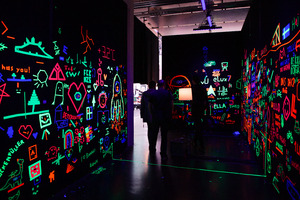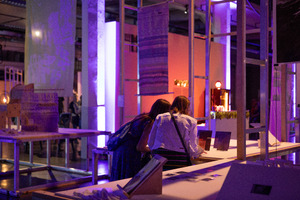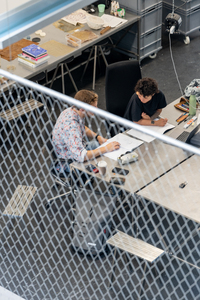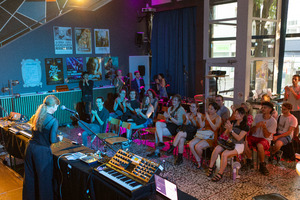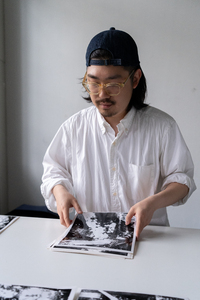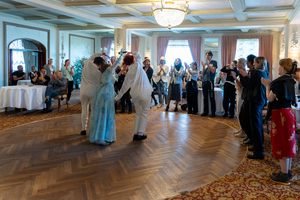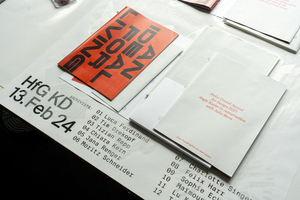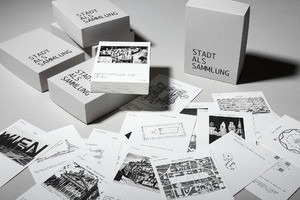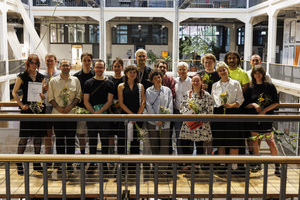Rundgang 2024
Sibling sets (15)Show all relations
This set is related to the same sets as the selected set.
15 Items
- Page 1 of 2
Rundgang 2025
- Title
- Rundgang 2025
- Subtitle
- Jahresausstellung der HfG Karlsruhe
- Description (de)
- Traditionell zum Ende des Sommersemesters lädt die Staatliche Hochschule für Gestaltung Karlsruhe zum alljährlichen Rundgang durch die Lichthöfe ein und gewährt für ein verlängertes Wochenende einen Blick hinter die Kulissen der Hochschule. Zum Rundgang 2025 unter dem Motto KIOSK, vom 24. bis 27. Juli, werden die Werkstätten, Lichthöfe und Räume der HfG Karlsruhe wieder zur Ausstellungsfläche.
Die große Jahresausstellung zeigt aktuelle Projekte aus allen Studiengängen und Fachgruppen – Kommunikationsdesign, Produktdesign, Medienkunst, Ausstellungsdesign & Szenografie sowie Kunstwissenschaft & Medienphilosophie. In den Lichthöfen der HfG und an weiteren Präsentationsorten in der Hochschule erhalten Besucher:innen Einblicke in rund 100 studentische Arbeiten. Darunter finden sich beispielsweise Performances, Installationen, Videos, Objekte und Texte. Ein begleitendes Veranstaltungsprogramm mit öffentlichen Führungen, Filmvorführungen, Gesprächen und weiteren Formaten, mitgestaltet vom Allgemeinen Studierendenausschuss der Hochschule, bietet über vier Tage hinweg Gelegenheiten zum Austausch mit Studierenden und Lehrenden.
Die HfG zeigt sich beim Rundgang als lebendiger Ort, an dem Kunst, Theorie und Gestaltung in interdisziplinären Projekten zusammenkommen. So entwerfen mit „THE NEST“ beispielsweise drei Studierende aus dem Fachbereich Produktdesign einen lebensgroßen, nestartigen Pavillon aus regionalen, bio-basierten Materialien wie Hanf, Holz und invasiven Pflanzen. Die Installation reflektiert ökologische Wertschöpfungsketten und entsteht in Kooperation mit dem Bio Design Lab, das sich an der HfG auf regenerative Materialien und nachhaltige Gestaltungsansätze spezialisiert.
Studierende aus dem Fachbereich Ausstellungsdesign und Szenografie wiederum präsentieren beispielsweise ein mobiles Bühnenbild, das ein spekulatives Zukunftsszenario für das Jahr 2034 entwirft – mit Blick auf ökologische Kipppunkte, globale Gerechtigkeit und politische Handlungsfähigkeit. Die Arbeit basiert auf dem Roman „Das Ministerium für die Zukunft“ von Kim Stanley Robinson und entsteht in Kooperation mit dem Theater Neumarkt sowie dem Collegium Helveticum Zürich.
Am Eröffnungsabend des Rundgangs, am 24.7.25 ab 19 Uhr, vergibt die Fördergesellschaft ZKM/HfG Preise für herausragende Abschluss- und Semesterarbeiten, die von Professor:innen aus allen Fachbereichen im Vorfeld der Ausstellung nominiert wurden.
Unter den diesjährigen Nominierten findet sich beispielsweise das Projekt der beiden Studierenden Sophie Reißfelder und Luise Peschko, mit dem Titel „Manchmal ist Schmerz ganz leise“: eine immersive, autobiographische Hörstück-Installation, die den stillen und oft unsichtbaren Kampf mit einer schweren, namenlosen Krankheit thematisiert. Eine Fachjury aus Wissenschaft, Kunst und Kultur wählt die Preisträger:innen aus den nominierten Arbeiten aus. Die Auszeichnungen ehren besondere Leistungen und unterstützen die Weiterentwicklung von Projekten.
- Traditionell zum Ende des Sommersemesters lädt die Staatliche Hochschule für Gestaltung Karlsruhe zum alljährlichen Rundgang durch die Lichthöfe ein und gewährt für ein verlängertes Wochenende einen Blick hinter die Kulissen der Hochschule. Zum Rundgang 2025 unter dem Motto KIOSK, vom 24. bis 27. Juli, werden die Werkstätten, Lichthöfe und Räume der HfG Karlsruhe wieder zur Ausstellungsfläche.
- Description (en)
- Traditionally, at the end of the summer semester, the Karlsruhe University of Arts and Design invites visitors to its annual tour of the atriums and offers a look behind the scenes of the university for a long weekend. The workshops, atriums and rooms of the HfG Karlsruhe will once again become an exhibition space for the 2025 tour under the motto KIOSK, from July 24 to 27.
The large annual exhibition will showcase current projects from all degree programs and subject groups - Communication Design, Product Design, Media Art, Exhibition Design & Scenography and Art Research & Media Philosophy. In the atriums of the HfG and at other presentation locations throughout the university, visitors can gain an insight into around 100 student works. These include performances, installations, videos, objects and texts. An accompanying program of events with public tours, film screenings, talks and other formats, co-organized by the university's General Student Committee, offers opportunities for exchange with students and teachers over four days.
During the tour, the HfG presents itself as a lively place where art, theory and design come together in interdisciplinary projects. With “THE NEST”, for example, three students from the Product Design department are designing a life-size, nest-like pavilion made from regional, bio-based materials such as hemp, wood and invasive plants. The installation reflects ecological value chains and was created in cooperation with the Bio Design Lab, which specializes in regenerative materials and sustainable design approaches at the HfG. Students from the Department of Exhibition Design and Scenography, on the other hand, are presenting a mobile stage set that creates a speculative future scenario for the year 2034 - with a view to ecological tipping points, global justice and political agency. The work is based on the novel “The Ministry for the Future” by Kim Stanley Robinson and is being created in cooperation with Theater Neumarkt and Collegium Helveticum Zurich.
On the opening evening of the Rundgang, on July 24 from 7 p.m., the ZKM/HfG Sponsorship Society will award prizes for outstanding final and semester projects nominated by professors from all departments in the run-up to the exhibition. This year's nominees include, for example, the project by the two students Sophie Reißfelder and Luise Peschko, entitled “Sometimes pain is very quiet”: an immersive, autobiographical audio piece installation that addresses the silent and often invisible struggle with a serious, nameless illness. A jury of experts from the fields of science, art and culture selects the winners from the nominated works. The awards honor special achievements and support the further development of projects.
- Traditionally, at the end of the summer semester, the Karlsruhe University of Arts and Design invites visitors to its annual tour of the atriums and offers a look behind the scenes of the university for a long weekend. The workshops, atriums and rooms of the HfG Karlsruhe will once again become an exhibition space for the 2025 tour under the motto KIOSK, from July 24 to 27.
- Date
- 24.07.2025 - 27.07.2025
- Title
- Rundgang 2025
- Imported on
- 13.05.2025
- Parent sets
- 1
- Set is related to
- 0 1
Gulaschprogrammiernacht 2024
- Title
- Gulaschprogrammiernacht 2024
- Description (de)
- 22. Gulaschprogrammiernacht des Entropia e.V. in HfG und ZKM
Die Gulaschprogrammiernacht (GPN) des Entropia e.V. ist wieder bei uns zu Gast! In diesem Jahr steht sie unter dem Motto Common Code <> Different Roots. Die GPN ist eine offene, spendenfinanzierte Communityveranstaltung mit Vorträgen, Workshops, einer Demoshow, Musik und dem traditionellen Gulasch als Verpflegung.
30. Mai - 02. Juni 2024 in den Lichthöfen der HfG
"Gulaschprogrammiernacht" klingt fast wie ein Kochmarathon für schlaflose Informatikstudierende. Was 2002 in einem Karlsruher Kellerraum mit ein paar Technikbegeisterten angefangen hat, ist inzwischen zu einer der größten Veranstaltungen des Chaos Computer Clubs gewachsen. Die Themen sind breit gefächert: Den Kern bilden Hard- und Softwareentwicklung, sowie Datensicherheit. Daneben kommen aber auch Datenschutz, Netzpolitik und viele andere faszinierende Themen zum Zug: Wie kocht man das perfekte Gulasch? Kann man aus Hardwareschrott noch schönen Schmuck basteln? Wie funktioniert eigentlich eine Nähmaschine? Wie fliegt man Raumschiffe?
Die Gulaschprogrammiernacht wird vom Entropia e. V. des lokalen Chaos Computer Club in Karlsruhe veranstaltet. In den Lichthöfen der Hochschule für Gestaltung (HfG) und den Vortragssälen des Zentrum für Kunst und Medien (ZKM) werden mehr als 1.500 Besucherinnen und Besucher erwartet. Trotz der inhaltlichen Tiefe, in die manche Vortragende eintauchen, richtet sich die Gulaschprogrammiernacht nicht nur an die »Digital Natives« oder Nerds. Alle sind willkommen und können etwas lernen.
Das Programmieren steht im Zentrum der GPN. In den Lichthöfen der HfG stehen dazu im »Hackcenter« Tische mit Strom- und Netzwerkanschluss bereit, an denen die Gäste ihre Zelte aufschlagen können. Ein großer Teil reist mit einem Projekt an, um auf der Gulaschprogrammiernacht ein paar fokussierte Tage und gegebenenfalls auch Nächte damit zu verbringen. Das heißt nicht, dass kein Austausch stattfindet. Im Gegenteil: Die meisten Hackenden, wenn sie nicht gerade in tiefster Programmiermeditation versunken sind, geben gerne Auskunft über ihr Steckenpferd. Auch gerade Fertiggewordenes wird gerne vorgeführt, und so wimmelt es auf der Gulaschprogrammiernacht von selbstgebauten Lichtinstallationen und Gerätschaften.
Der zweite Hauptbestandteil einer Gulaschprogrammiernacht - neben den Aktivitäten im Hackcenter - ist das Workshop- und Vortragsprogramm. Von tief in die Materie gehenden Vorträgen aus Hard- und Softwareentwicklung über lehrreiche (und humorvolle) Anekdoten aus dem alltäglichen Programmierwahnsinn bis zu netzpolitischen Debatten ist alles vertreten. Bei Löt- und Bastelworkshops können Elektronik-Skills verbessert werden, Lightning Talks bieten eine offene Bühne für spontane Kurzvorträge, und auch die Demoszene erfreut sich stets großer Beliebtheit.
Das diesjährige Motto ist "Common Code <> Different Roots". Es gibt viel "Common Code", den wir jeden Tag in unserem digitalen und analogen Leben nutzen. Wo liegen die Wurzeln dieser Codes? Wie arbeiten sie zusammen? Wie wächst daraus ein Baum? Was ist mit der Community hinter dem Code? Wie sieht die Zukunft unseres Baumes aus?
Die Gulaschprogrammiernacht ist eine offene Veranstaltung für alle. Eine vorherige Anmeldung ist erwünscht, eine Spende wird erbeten.
- 22. Gulaschprogrammiernacht des Entropia e.V. in HfG und ZKM
- Description (en)
- 22. Gulaschprogrammiernacht of Entropia e.V. in HfG and ZKM
The Goulash Programming Night (GPN) of Entropia e.V. is back with us! This year's motto is Common Code <> Different Roots. The GPN is an open, donation-financed community event with talks, workshops, a demo show, music and the traditional goulash for refreshments.
May 30 - June 02, 2024 in the atriums of the HfG
“Goulash programming night” almost sounds like a cooking marathon for sleepless computer science students. What started in 2002 in a basement room in Karlsruhe with a few technology enthusiasts has now grown into one of the Chaos Computer Club's biggest events. The topics are wide-ranging: The core is hardware and software development, as well as data security. However, data protection, network policy and many other fascinating topics are also covered: How do you cook the perfect goulash? Can you make beautiful jewelry out of hardware scrap? How does a sewing machine actually work? How do you fly spaceships?
The Goulash Programming Night is organized by Entropia e. V. of the local Chaos Computer Club in Karlsruhe. More than 1,500 visitors are expected in the atriums of the University of Arts and Design (HfG) and the lecture halls of the Center for Art and Media (ZKM). Despite the depth of content that some of the speakers will delve into, the Goulash Programming Night is not just aimed at “digital natives” or nerds. Everyone is welcome and can learn something.
Programming is at the heart of the GPN. Tables with power and network connections are set up in the “Hackcenter” in the atriums of the HfG, where guests can pitch their tents. A large number of people travel to the Goulash Programming Night with a project to spend a few focused days and even nights working on it. This does not mean that there is no exchange. On the contrary: most hackers, when they are not immersed in deepest programming meditation, are happy to provide information about their hobbyhorse. They also like to show off what they have just finished, and so the Goulash Programming Night is teeming with self-built light installations and devices.
The second main component of a Goulash Programming Night - in addition to the activities in the Hackcenter - is the workshop and lecture program. From in-depth lectures on hardware and software development to instructive (and humorous) anecdotes from everyday programming madness and debates on net politics, everything is represented. Electronics skills can be improved at soldering and tinkering workshops, lightning talks offer an open stage for spontaneous short presentations, and the demo scene is always very popular.
This year's motto is “Common Code <> Different Roots”. There is a lot of “common code” that we use every day in our digital and analog lives. Where are the roots of these codes? How do they work together? How does a tree grow from it? What about the community behind the code? What does the future of our tree look like?
The Goulash Programming Night is an open event for everyone. Prior registration is required, a donation is requested.
- 22. Gulaschprogrammiernacht of Entropia e.V. in HfG and ZKM
- Date
- 30.05.2024 - 02.06.2024
- Location: institution
- Internetlinks
- Title
- Gulaschprogrammiernacht 2024
- Imported on
- 30.08.2024
- Parent sets
- 1
- Set is related to
- 0 12
KAMUNA 2024
- Title
- KAMUNA 2024
- Subtitle
- Karlsruhe Museumsnacht
- Description (de)
- Die HfG ist in diesem Jahr zum zweiten Mal als offizieller Partner Teil der Karlsruher Museumsnacht KAMUNA mit einem eigenen Programm in den Lichthöfen.
Am 3. August 2024 öffnen wir ab 18.00 Uhr die Türen mit folgenden Highlights:
Ausstellung: Aktuelle Arbeiten von Studierenden und Projekte aus den Studiengängen Ausstellungsdesign und Szenografie, Kommunikationsdesign, Kunstwissenschaft und Medienphilosophie, Medienkunst sowie Produktdesign der HfG in Lichthof 3+4.
Ausstellung: Ausgewählte Ergebnisse des HfG-Schnupperstudiums, die Schülerinnen und Schüler zwischen 16 und 20 Jahren in Workshops 5 Tage lang kreativ erarbeitet haben in Lichthof 3+4.
Robotic Soundscape: Interactive Robotic Sound Art Performance mit dem Maschinenkunst-Pionier und Medienkünstler Kal Spelletich - Eine Gruppenperformance von Nachwuchskünstlerinnen und -künstlern der HfG mit einem Maschinenorchester aus interaktiven Klangrobotern, elektromechanischen Klangerzeugern und automatischen Instrumenten exklusiv für die KAMUNA. Beeinflusst von der Arbeit von Terry Riley, Kraftwerk, David Tudor, John Cage, den Einstürzenden Neubauten und Pauline Oliveros wird eine einzigartige Soundscapekomposition erschaffen. Dies ist die seltene Gelegenheit, eine von Kal Spelletichs Performances zu erleben. Aufführungen um 20 Uhr und um 21 Uhr im großen Studio
Illuminating Nature: Interaktiver Workshop über (biolumineszente) Pilze - Das Bio Design Lab an der HfG und das Hertzlab am ZKM weihen in diesem praktischen Crossover-Projekt in die wilde Welt der organischen Netzwerke der Pilze ein. Praktische Hands-on Performance mit dem biolumineszierenden Myzelium des Herben Zwergknäuelings (Panellus stipticus) plus Wissenswertes über Pilze als Nutzorganismen und warum sie sich so gut für Medienkunst eignen. 21:00 - 0:00 im Bio Design Lab in Lichthof 4.
Gemeinsame Ausstellung von HfG und ZKM: Antennae: Frequencies from the Archive - Entwickelt von einer Seminargruppe des Studiengangs Ausstellungsdesign und Szenografie der HfG und kuratiert von Nick Aikens, Céline Condorelli im Dialog mit Felix Mittelberger.
Gemeinsame Studio-Ausstellung von HfG und Städtischer Galerie Karlsruhe: „Hydromedia. Seeing with Water“ - Erarbeitet im Frühjahr 2024 an der HfG Karlsruhe im Rahmen des EU-geförderten künstlerischen Forschungsprojekts „Hydromedia“
- Die HfG ist in diesem Jahr zum zweiten Mal als offizieller Partner Teil der Karlsruher Museumsnacht KAMUNA mit einem eigenen Programm in den Lichthöfen.
- Description (en)
- This year, the HfG is part of the Karlsruhe Museum Night KAMUNA for the second time as an official partner with its own program in the atriums.
On August 3, 2024, we will open the doors from 6 p.m. with the following highlights
Exhibition: Current works by students and projects from the exhibition design and scenography, communication design, art studies and media philosophy, media art and product design courses at the HfG in Lichthof 3+4
Exhibition: Selected results of the HfG taster course, which students between the ages of 16 and 20 worked on creatively in workshops over 5 days in Lichthof 3+4
Robotic Soundscape: Interactive Robotic Sound Art Performance with machine art pioneer and media artist Kal Spelletich - A group performance by young artists from the HfG with a machine orchestra of interactive sound robots, electromechanical sound generators and automatic instruments exclusively for KAMUNA. Influenced by the work of Terry Riley, Kraftwerk, David Tudor, John Cage, Einstürzende Neubauten and Pauline Oliveros, a unique soundscape composition will be created. This is a rare opportunity to experience one of Kal Spelletich's performances. **Performances at 8 pm and 9 pm in the Studio.
Illuminating Nature: An Interactive Workshop on (Bioluminescent) Fungi - The Bio Design Lab at the HfG and the Hertzlab at the ZKM will introduce you to the wild world of organic fungal networks in this practical crossover project. In a practical hands-on performance, we will bring the bioluminescent mycelium of the Panellus stipticus into your living room. Along the way you will learn interesting facts about fungi as useful organisms and why fungi are so well suited for media art. Time: 21:00 - 0:00 at the Bio Design Lab in Lichthof 4.
Joint exhibition by HfG and ZKM: Antennae: Frequencies from the Archive - Developed by a seminar group from the exhibition design and scenography course at HfG and curated by Nick Aikens, Céline Condorelli in dialog with Felix Mittelberger.
Joint studio exhibition by HfG and Städtische Galerie Karlsruhe: “Hydromedia. Seeing with Water” - Developed in spring 2024 at the HfG Karlsruhe as part of the EU-funded artistic research project ”Hydromedia”
- This year, the HfG is part of the Karlsruhe Museum Night KAMUNA for the second time as an official partner with its own program in the atriums.
- Date
- 03.08.2024
- Location: institution
- Internetlinks
- Title
- KAMUNA 2024
- Imported on
- 30.08.2024
- Parent sets
- 1
- Set is related to
- 0 23
Dusting. Ecosystems with images and codes
- Title
- Dusting. Ecosystems with images and codes
- Title (en)
- Dusting. Ecosystems with images and codes
- Description (en)
- “No matter how desperately you fight against it, dust pervades everything. It accumulates in fuzzy balls or gathers in even layers, adapting to the contours of things and making the passage of time. In itself, it is also a gathering place, a random community of what has been and what is yet to be, a catalog of traces, an inventory of threats, and a set of promises… “ Michael Marder, “Dust” 2016 In this seminar we will look at different situations with images and codes where dust engages as a medium to understand the complex interrelation between the content of an image and its making, its meta-data and its technological and ecological being in the world. The seminare is practical as well as theoretical. We will dust together, and we will wait for dust to settle: on paper, in space, in our minds, and we will research and engage in dust experiments together: from field trips to laboratory visit to exhibition visits. At the end of the seminar the aim is to have delevoped a presentation, be it an image series, an installation, or/ and a research exhibition. This will be presented during the Rundgang. Prof. Susanne Kriemann organises an excursion to Vienna 24th to 27th of April to see the exhibition “Into the Woods” at KunstHausWien and the first “Klima-Biennale”.
- Type of project / creative work
- Date
- 30.04.2024 - 16.07.2024
- Title
- Dusting. Ecosystems with images and codes
- Projektleiter/in
- Semester
- Program of Study
- Imported on
- 22.08.2024
- Parent sets
- 1
- Set is related to
- 0 25
Ghosts of Grand Hotels 2024
- Title
- Ghosts of Grand Hotels 2024
- Title (en)
- Ghosts of Grand Hotels 2024
- Subtitle
- Ausstellung der Seminararbeiten
- Description (de)
- Willkommen im Grand Hotel, liebe Passagiere! Das Reisebüro Ghostly Matters bietet Ihnen eine saisonale Fahrt durch die weite, unheilvolle Landschaft des Schwarzwalds mitten in das Herz eines ehemaligen Grandhotels: Waldlust. Seine offenen Türen verbreiten den einzigartigen Duft von Urlaub, Klassizismus, Kunst und Luxus. Entdecken Sie mit uns die unerzählten Erzählungen seiner Wände, Möbel, Küche, Mitarbeiter und Gäste, die das Internationale mit dem Lokalen verbinden. Welche Spuren hinterlassen sich nach dem Verlassen der Zimmer im Hotel? Unser Team empfängt Sie am 5. Juli in Freudenstadt zu einem außergewöhnlichen Besuch der Ausstellungsstätte Waldlust. Die kommende Ausstellung ist die Fortsetzung einer kritischen und spielerischen Auseinandersetzung mit dem Erbe und dem zeitgenössischen Status von Grand Hotels. Welche Geister verfolgen uns in den Räumen des klassizistischen und kolonialen Luxus, in den Kammern der Fürsorge und Gastfreundschaft und in den Treffpunkten von Künstlern und wohlhabendem Bürgertum? Welche Zukünfte könnten aus einem Pool verschiedener Zeitlichkeiten entstehen? Die Ausstellung ist eine Kooperation zwischen Waldlust e.V., HfG Karlsruhe, ABK Stuttgart und Hochschule Offenburg.
- Description (en)
- Welcome to Grand Hotel, dear passengers! The travel agency Ghostly Matters offers you a seasonal ride through the vast, ominous landscape of the Black Forest right into the heart of a former Grand Hotel: Waldlust. Its open doors are spreading the unique odor of holidays, classism, art and luxury. Discover with us the untold narratives of its walls, furniture, kitchen, employees and guests, that merged the international and the local. Which traces are inscribed in the hotel after the rooms are left? Our Team will welcome you on the 5th of July in Freudenstadt for a remarkable visit to the exhibition setting at Waldlust. The upcoming exhibition is the continuation of a critical and playful exploration on the legacy and contemporary status of grand hotels. Which ghosts are haunting us in the spaces of classicist and colonial luxury, the chambers of care work and hospitality and meeting places of artists and wealthy bourgeoisie? Which futures could emerge out of a pool combining various temporalities? The exhibition is a collaboration between Waldlust e.V., HfG Karlsruhe, ABK Stuttgart and Hochschule Offenburg.
- Category
- Type of project / creative work
- Date
- 25.04.2024 - 31.07.2024
- Contributors
- Location: institution
- Location
- Hotel Waldlust Freudenstadt
- City
- Country
- Participating institution(s)
- Title
- Ghosts of Grand Hotels 2024
- Projektleiter/in
- Semester
- Program of Study
- Course, Lecture, Seminar
- Imported on
- 22.08.2024
- Parent sets
- 1
- Set is related to
- 0 11
KD Vordiplomspräsentation SS 2024
- Title
- KD Vordiplomspräsentation SS 2024
- Category
- Date
- 04.07.2024
- Location: institution
- City
- Country
- Title
- KD Vordiplomspräsentation SS 2024
- Copyright Notice
- © Staatliche Hochschule für Gestaltung Karlsruhe
- Semester
- Program of Study
- Type of graduation project
- Imported on
- 22.08.2024
- Parent sets
- 0
- Set is related to
- 0 11
Stadt als Sammlung
- Title
- Stadt als Sammlung
- Author
- Description (de)
- Das Projekt „Stadt als Sammlung“ ist ein interdisziplinäres Forschungsprojekt, das sich mit den Herausforderungen und Potenzialen des analogen und digitalen Archivierens und Sammelns auseinandersetzt.
- Description (en)
- The project "Stadt als Sammlung" is an interdisciplinary research project that deals with the challenges and potentials of analog and digital archiving and collecting.
- Category
- Keywords
- Contributors
- Location: institution
- Location
- 1. OG, mittlere Lichtbrücke
- Title
- Stadt als Sammlung
- Projektleiter/in
- Semester
- Program of Study
- Type of graduation project
- Imported on
- 07.08.2024
- Parent sets
- 0
- Set is related to
- 1 5
Rundgang 2024 - Preisverleihung
- Title
- Rundgang 2024 - Preisverleihung
- Description (de)
- Am Eröffnungsabend des Rundgangs wurden studentische Arbeiten unterschiedlicher Fachbereiche ausgezeichnet - dank großer Unterstützung der Fördergesellschaft ZKM / HfG, der Gunther-Schroff-Stiftung, der Heinrich-Hertz-Gesellschaft, der Badischen Beamtenbank, der Riemschneider Stiftung und auch privaten Preisgebern. Sie ermöglichen es durch ihre Finanzierungen den Studierenden neben der Anerkennung ihrer Leistungen, ihre Projekte weiterzuführen und neu anzustoßen.
Die HfG Karlsruhe bedankt sich herzlich bei allen Förderern und Stiftern und gratuliert an dieser Stelle noch einmal ausdrücklich allen Nominierten dieses Jahres sowie den Gewinner:innen:
Gunther-Schroff-Preis mit 5.000 €: Henriette Schwabe, Jaya Demmer - JJxH54D – Spring Collection
Preis I der Fördergesellschaft mit 4.000 €: BookBoi
Preis II der Fördergesellschaft mit 2.500 €: Rita Andrulyte - Path Tiles – Knitting Coordinates into Patterns
Preis der BBBank mit 1.500 €: Calvin Kudufia - A man in the shape of…
Preis III der Fördergesellschaft mit 1.000 € : Alicia Luna Ripp- Spellbound
Preis IV der Fördergesellschaft mit 1.000 €: Amelie Enders – ZWISCHEN-RÄUME_N
Achim & Melanie Krämer-Preis mit 1.000 €: Víctor Fancelli Capdevila - Who cares? - Digitale Sozialität, Infrastrukturen der Fürsorge und konviviale Technologien
Preis der Heinrich-Hertz-Gesellschaft mit 2.000 €: Schwarm Publication Issue 2 Delusions
Preis der Riemschneider Stiftung: Kevin Beckmann, Alexander Thelen, Masterclass mit Ida Bregninge unter der Leitung von Marine Hugonnier
- Am Eröffnungsabend des Rundgangs wurden studentische Arbeiten unterschiedlicher Fachbereiche ausgezeichnet - dank großer Unterstützung der Fördergesellschaft ZKM / HfG, der Gunther-Schroff-Stiftung, der Heinrich-Hertz-Gesellschaft, der Badischen Beamtenbank, der Riemschneider Stiftung und auch privaten Preisgebern. Sie ermöglichen es durch ihre Finanzierungen den Studierenden neben der Anerkennung ihrer Leistungen, ihre Projekte weiterzuführen und neu anzustoßen.
- Date
- 18.07.2024 - 21.07.2024
- Contributors
- Location: institution
- Location
- Lichtbrücke, Bühne
- City
- Participating institution(s)
- Title
- Rundgang 2024 - Preisverleihung
- Semester
- Imported on
- 29.07.2024
- Parent sets
- 1
- Set is related to
- 0 4

